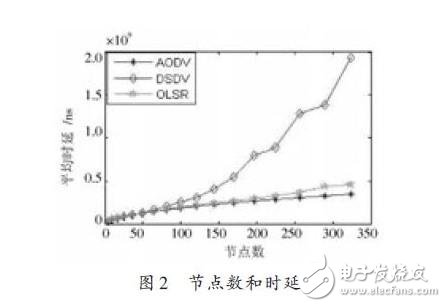0 Preface
With the rapid development of network technology and communication technology, how to study large-scale networks without hardware conditions, how to design quickly. achieve. Analysis of new protocols and algorithms, how to compare new and old systems and algorithms without having to spend huge sums of money to build actual systems has become a focus of network researchers. In recent years, the prevailing approach has been through computer software to network protocols. Network topology. Network performance is simulated. The use of this network simulation research method reduces the cost, the research method is flexible and reliable, and the research efficiency is improved. The main mainstream network simulation tools are: OPNET, QualNet, NS-2. OPNET is commercial software. The model library provided by the software is limited, and it mainly focuses on route simulation. QualNet is also a commercial software that weakens the concept of network layering. The content of NS-2 is quite complicated, and the coordination and coupling between modules is not convenient for system expansion. To this end, based on the successful experience of extensive use of existing network simulators, Professor Thmos R. Henderson of the University of Washington and his team developed a unique new network simulator - NS-3. Compared to other networks. Simulation tool, NS-3 is an open source software that shows better features in multi-NIC processing and IP addressing strategies. At the same time, the architecture of NS-3 is relatively clearer and clear, and the code does not need to be modified. Direct migration to real network nodes, in addition, researchers can expand according to their own needs.
1 MANET routing protocol analysis
Mobile Wireless Ad Hoc Network (MANET) is a centerless. Self-organized distributed multi-hop network, MANET has been widely used in some special scenarios (such as disaster relief, war, etc.) with its inherent characteristics. The quality of the routing protocol directly affects the performance of the entire network. Here is a brief introduction to the three types of planar routing protocols that are widely used in MANET. DSDV (DesTInaTIon-Sequenced Distance Vector) is a table-driven routing protocol, which is based on the traditional distance vector DV algorithm. It is also called the Bellman-Ford routing algorithm for eliminating loops. Each node in the DSDV algorithm maintains a routing table that reaches the reachable destination node of the entire network. Compared with the DV algorithm, the biggest difference between DSDV is that the destination sequence number field is added to the route, and the new and old routing information is distinguished by the serial number. The node compares the received new routing information with the current routing information, and selects a routing record with a larger serial number to update the routing table. If the serial numbers of the two are the same, the one with the smaller hop count is selected.
In addition, the entire network node requires periodic broadcast routing packets for route maintenance. AODV (Ad Hoc On-Demand Distance Vector) is a source-driven routing protocol designed by combining the DSR protocol with the on-demand routing mechanism in DSDV. When a node sends a data packet, it first searches its routing table for routing information to the destination node. If it does, it sends the routing information directly; if not, it performs the route discovery process. The node broadcasts the routing request packet RREQ to its neighbor. After receiving the RREQ packet, the neighbor queries its own routing table to find the routing information of the destination node. If it is or is the destination node, the routing information is added to the routing response packet RREP. Feedback to the source node; if not, forward the RREQ to all of its neighbors. And so on, until there is a route to the destination node or intermediate node to reach the destination node.
The AODV protocol performs route maintenance by periodically broadcasting Hello packets. Once a communication link is found to be disconnected, the node deletes the route containing the broken link from the routing table after the DE-LEte_PERIOD time, and sends an ERROR ( A routing error is sent to notify nodes that are unreachable due to link disconnection to delete corresponding routing records or to repair and update the already stored routing information.
OLSR (OpTImized Link State RouTIng) is an optimized link state routing protocol. Similar to other table-driven routing protocols, nodes need to periodically exchange network routing information. A node selected as a relay node (Multi Point Telay, MPR) by a neighbor node periodically broadcasts a control information packet to the network, and the packet includes information of those nodes that select it as MPR to tell other nodes in the network and these nodes. Connected. Moreover, only the MPR node can be used as a routing node, and other non-MPR nodes do not participate in route calculation, nor need to relay control information. In the OLSR protocol, the broadcast topology is mainly perceived by two control messages, HELLO and TC (Topological Control). Link detection is implemented by HELLO message. The neighbor listens to establish a local link information table of the node, and is used to notify the neighbor node of the selection of the multipoint relay MPR node of the node; the TC message is responsible for executing the MPR Selector link state declaration, so that each node is Ability to perceive the entire network topology. Finally, the node uses the Dijkstra algorithm to calculate the routing table according to the shortest path according to the information in the local link information base and the topology set.
2 NS-3 simulation platform to build
2.1 NS-3 simulation architecture
NS-3 is a discrete simulator. The network architecture of NS-3 is mainly composed of two parts: simulator core and network component, as shown in Figure 1. The simulator core includes a time scheduler and a network simulation support system, which is the core part of the NS-3. Compared to NS-2, NS-3 simulation time not only supports Default Scheduler, but also supports Realtime Scheduler.

The network simulation support system of NS-3 includes: Attribute system. Logging system and Traching system. The NS-3 core is measurable due to extensive experience and technology from other network simulation tools. Scalability. Modular. Supporting simulation and reality integration has great advantages. The network components of NS-3 include: Node. Application (Application). Protocol Stack. Network Device (Net Device). Channel. Topology Builder (Helper), etc. The network component is an abstraction of various parts of the real network, with low coupling and high cohesion characteristics. The NS-3 uses low-level abstraction to make the simulation effect reflect the performance of the real network as much as possible.

Power: 220V-240V 50/60Hz 1200W, Motor : Dual driving
1.Stepless speed control with pulse function2.Two driving connector for different attachments
3.Rotary chrome switch
4.Transparent splash-proof cover
5.5.8L stainless steel bowl(SUS 304)
6.Non slip feet
7.Power cord hiding box
8.Dishwasher safe attachments
9.Unique dough hook & mixer whisk are included.
10.Low noise, environment friendly
11.Cord length: 1.2m




Electric Mixer Price,Electric Cake Mixer,Best Electric Mixer,Electric Food Mixer
Housoen Electric Manufacture Co., Ltd. , https://www.housoenappliances.com